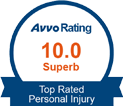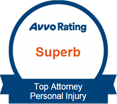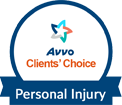It can be stressful to determine liability after a car accident. However, it's necessary to do this to secure compensation if you believe someone else's negligence caused the accident. Although you aren't to blame for the car crash, it's imperative to have a clear strategy for determining liability for the person who caused the accident. Hiring an experienced personal injury attorney to represent you puts you in a better position of proving liability in a car accident. Read on and learn how our attorney will help determine the liability of the other motorist.
Establish that the Other Driver Had a Duty of Care
All drivers must drive their vehicles reasonably, ensuring safety to other pedestrians, motorists, and passengers on the road. A breach of any of their responsibility can be found as an act of negligence. This provides an opportunity where a victim can seek a liability claim against the at-fault driver. The following are typical duties that a driver has on the road.
Duty to Drive at a Reasonable Speed
All drivers must drive at a reasonable and safe speed. They must also drive slowly during harsh weather conditions when approaching traffic and when there’s poor visibility.
Duty to Maintain the Vehicle in Good Condition
Driving a faulty or poorly maintained vehicle is one of the major causes of car accidents. Unfortunately, most drivers know that their cars need maintenance but end up putting their vehicles on the road, which risks their safety and other road users.
Observing Traffic Regulations
Drivers have the responsibility of observing traffic regulations. However, you will find several drivers floating these regulations due to lateness, leading to a car accident. Some of the common traffic regulations include:
- Yielding when turning left
- Keeping left unless overtaking
- Slowing down when approaching an intersection, pedestrian crossing, or a road corner
- Avoid parking near a road cross, on top of a hill, or at the shoulder of a highway
- Maintain an adequate distance between your vehicle and the one on the front
- Adhere to the direction given to you through a police officer or traffic signal
- Giving way to pedestrians
Duty to Be on the Lookout
Every driver must be aware of their environment, know about the potential hazards and confront them. Failure to be on the lookout might make them liable for the car accident that they cause. For instance, failure to be on the lookout at a place like construction or a school zone where you're supposed to slow down can easily lead to a car accident, making you liable for it.
Establish that the Other Driver Breached His or her Duty of Care
A breach of care implies a violation of the burden of responsibilities that are noted above. Drivers breach their duty of care whenever they handle their vehicle in a way that would cause a car accident.
The term "reasonable person" is used in this kind of situation. Your defense must aim to prove that the accused driver behaved in a way that a prudent person wouldn't have acted. If your defense establishes that the driver didn't act prudently or vigilantly, it implies that the driver's actions were reckless or negligent. Some of the common examples of breach of duty of care include:
Following Too Closely
When two drivers are traveling in the same direction on a highway, the vehicle that's following must maintain about ten feet from behind the one at the front. Otherwise, if something forces the first driver to make a sudden stop, there are chances that the vehicle on the rear will ram the other one from its back. This puts the driver at the rear, liable for the car accident.
Driving in A Bad Weather
Heavy rain and ice make the road slick. These phenomena also reduce visibility, meaning that you cannot see the vehicle at the front easily. As a result, there are possibilities of causing a rear-end accident with it once it stops suddenly. Although bad weather itself is a natural phenomenon, driving without accounting for the weather makes you negligent for the accident that you cause.
Driving While Under the Influence or DUI
DUI is a typical example of a breach of duty. Drivers know that it's not safe to drive while intoxicated. Therefore, a driver that causes an accident when intoxicated is negligent.
Road Rage
Drivers who commit road rage breach their duty of care. Road range can be more severe than negligence and is also considered as intentional misconduct or carelessness. A driver should not retaliate even when offended by another driver on the road. Taking an action that's motivated by road rage is a breach of conduct.
Running a Light
When two drivers are approaching an intersection, one must stop to allow the other driver to make it through. If the driver proceeds while the light is red, this might lead to an accident. This negligent action can also apply when a driver fails to stop when the other driver is turning left.
Driving While You're Fatigued
Drivers have a limited timeline to operate their vehicles before they rest. Exceeding the required timeline reduces a driver's level of attention and can start drifting in and out of lane, crossing the centerline, and probably collide with an oncoming car. Therefore, drivers who drive when they are too tired are considered to have breached their duty of care.
Driving Too Fast When Approaching a Corner
Drivers must slow down when approaching a corner, take note of the environment and proceed when the road is clear. If a driver fails to consider these factors, he or she becomes negligent if he or she causes an accident as a result.
Texting while Driving
The few seconds drivers take their eyes off the road to send a text are long enough to cause a car accident. Texting causes a driver to divert attention from the tasks at hand. If an accident happens, the driver becomes negligent for the accident.
Failure to Maintain Control of a Vehicle
Failure to maintain control of a vehicle refers to things like stopping over a line at an intersection, making sudden stops, and swerving in and out of lanes.
Neglecting Maintenance
Drivers must keep their vehicles in perfect working condition. It's the driver's responsibility to address the issue at hand when a car has some issues. Of course, drivers always don't know about these issues, but this becomes a negligent action if an accident occurs.
Driving with a Known Medical Issue
Drivers with a medical condition like epilepsy are warned to avoid operating a motor vehicle. However, if such people fail to adhere to this requirement and cause an accident after a medical event, they become liable for causing the accident.
Although most of the accidents occur due to driver's negligent actions, other factors are not necessarily a result of driver's negligence. These factors include:
- Vehicle Defect: Sometimes, a car can have an inherent defect. This kind of defect occurs when there is an error in the manufacture, design, or installation of a particular vehicle part. Drivers don’t breach their duty of care when their vehicles cause an accident due to the defect. This applies regardless of the reason that led to the accident.
- A Chain Reaction: A driver who collides with another vehicle may not be guilty of negligence if the cause was an accident chain reaction. For instance, when two cars are driving in the same direction on a highway, and one of them strikes the other when changing lanes, pushing the second one into the oncoming lane, the second is not responsible for the accident.
Establish that the Other Driver's Negligence Caused Your Injuries
It's much easier to establish that you broke your arm or suffered a cut from a car accident once you go to a hospital after a wreck. However, invisible symptoms like headaches, memory loss, anxiety, and back pain make it challenging to establish negligence. For instance, a frequent headache might result from whiplash but can be caused by something else like outdated glasses prescribed to your treatment.
This might be a significant challenge since most car insurance firms partly pay settlements for accident victims. They usually pay up for the emergency medical treatment and leave out any expenses incurred in your follow-up treatment. If the at-fault car insurance fails to pay up the required amount, the best decision is to file a lawsuit to ensure that your settlement is made fully.
You need to have enough documents to use as evidence after filing a lawsuit against the driver who caused your injuries. Sometimes, the at-fault party might decide to pay off the amount you're requesting or an amount nearing your expectations due to the airtight evidence that you have. In that case, an insurance firm might pay off the policy limits since the jury might force them to pay more than the amount allowed by their policy limit at a trial. Usually, the court finds the at-faults insurance company to have put their policyholder at risk.
It’s crucial to gather enough evidence immediately after incurring an accident to avoid making any mistake that might affect your claim. You must also be assessed by a professional medical expert immediately after an accident, even when you're feeling fine if you want to gather enough evidence. This will help you use your medical records to prove that you were involved in an accident and a professional doctor was involved in your treatment.
Even so, any pain that you suffer after your emergency treatment might prompt the at-fault driver to argue that these symptoms are unrelated to the accident and you're trying to blame it on him or her. That's why it's advisable to avoid giving any incriminating statement to the at-fault driver's insurance company before you talk to an attorney.
Another crucial aspect in a personal injury case is avoiding action or statement that appears to contradict your injury claim. For example, returning to work as soon as possible following your recovery from a car accident is not advisable. It allows the at-fault defense attorney to argue that you probably were not injured since you could return to work immediately.
The best thing to do is hold off for a while until your injuries are completely healed and a significant amount of your pain has gone. Other actions you must avoid are:
- Going to vacation
- Recreational activities that require any physical effort
- Volunteering in any actions that require physical activity or labor
At-fault parties in a car accident are adamant in settling the damages incurred due to their negligence. They will probably blame any symptoms that you experience on several things related to your medical history. In this situation, your attorney will rely on your medical records to confirm that the injuries resulted from a car accident.
In unclear situations, your attorney can bring medical experts to interpret the records based on their expertise to prove what your doctor is saying about the injuries you suffered from the car accident.
Establish that Your Accident Led to Damages
Proving your damages after a car accident can be challenging since the at-fault party will contend that the damages are much lower than what you ask. Your proof depends on the type of damages you've incurred. Below is an overview of how you can prove common types of damages after a car accident.
Proving Your Medical Expenses
You can only prove that you incurred medical expenses through medical bills and receipts. These receipts confirm that expenses were incurred and can be used as an exhibit during your lawsuit. The receipts can also establish that the doctors provided the medical services on time. Fortunately, most health insurance carriers and medical offices keep documentation of bills collected and introduced to the jury or adjuster.
Proving Your Loss of Income
Missing time for work after a car accident can cause significant financial loss. The right to reimbursement applies whether you have a full-time job, part-time job, or self-employed. Here are some of the ways you can prove your loss of income:
A Note of Paid Vacation or Sick Leave
Taking sick leave or a paid vacation due to your car accident injuries can prove your loss of income. That's why it's recommendable to have the right documents to prove this.
Other workable ways that can help you prove your lost wages include:
- Your W-2(s) documents from last year.
- Your Paystubs.
- A document from your employer that can verify your wages. This includes a salary or wage verification form or a note from your employer listing your normal wages.
- If you're self-employed or a business owner, you can provide documentation like your tax returns, account receivable, and your business' banking records.
Proving Your Pain and Suffering
There's no specific formula to prove your pain and suffering. That's why your argument must be logical, based on facts, and supported by relevant evidence. Below are some of the pieces of evidence you can use to prove your pain and suffering:
- A note from your doctor restricting you from lifting more than ten pounds
- A prescription by your doctor to treat your sleep insomnia and nightmares
- A statement that shows that you can't drive for two weeks and are forced to rely on someone else to take your children home
- A report from your counselor proving that you were depressed after the car accident
You can also use photographs throughout your treatment to give a clear picture of your pain and suffering. This includes photos of your mangled car while in a hospital bed and during rehabilitation.
Proving Loss of Consortium
Loss of consortium refers to the loss of companionship, love assistance, protection, society, and intimacy. Relatives and parents can establish grounds for a loss of consortium if their husband, wife, or registered domestic partner are car accident victims. Some of the aspects that you can use to prove your loss of consortium include the following:
- Proving that your spouse was irritable, moody, or touchy after the accident
- Proving that your spouse was stressed or depressed out and was unable to encourage or counsel you due to your suffering
- Prove that your spouse can’t help in your domestic duties
- Prove that you and your spouse have been unable to have sexual relations
- Prove that your spouse has been unable to help in childrearing, leaving you to handle everything on your own
- Prove that you haven’t been able to participate in your favorite hobbies together after the car accident
Hire a Reliable Car Accident Attorney Near Me
Our priority as a San Diego personal injury attorney is to maximize our clients' results. With our vast experience, our team is primed to secure the best compensation in your car accident lawsuit. We also handle all other forms of personal injury litigations on behalf of our clients. Please call us at 619-625-8707 and speak with one of our lawyers. We look forward to discussing your unique legal concerns and needs.
 800-492-6718
800-492-6718







